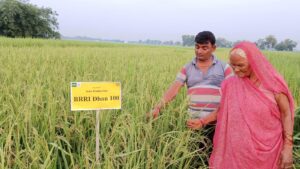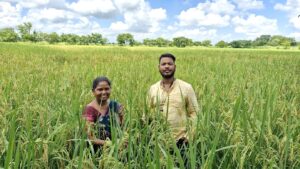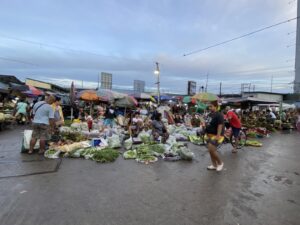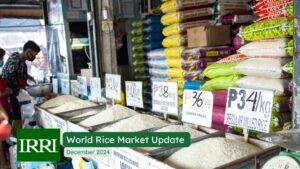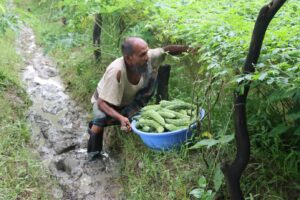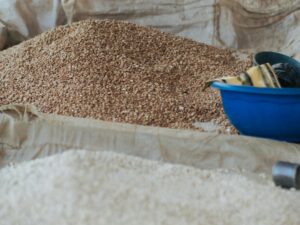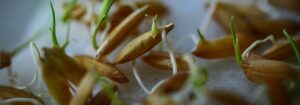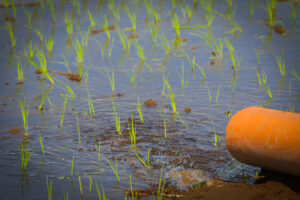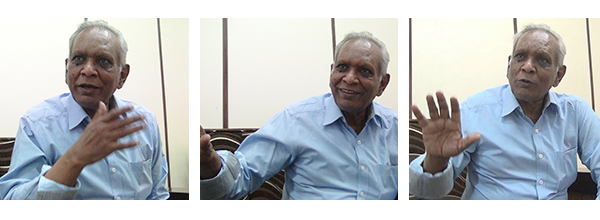
The legendary Ebrahimali Abubacker Siddiq, 78, began his long and enduring rice research career in 1968 as a cytogeneticist at the Indian Agricultural Research Institute (IARI) in New Delhi, including 7 years there as a senior scientist. In 1983-86, he spent 3 years as a breeder for the International Rice Research Institute (IRRI) in Egypt. Returning to IARI, he was appointed professor of genetics (1986-87).
In late 1987, he became project director at the Directorate of Rice Research (DRR). In 1994, he assumed the position of deputy director general (crop science) of the Indian Council of Agricultural Research (ICAR). In 2000-05, he served as a member of the Institute’s Board of Trustees from 2000 to 2005. His 35 years of research in plant breeding contributed to the development and release of high-yielding semidwarf basmati and nonbasmati varieties, which have boosted rice production in India.
Upon retirement from his regular ICAR service in 1997, ICAR named him a national professor (1997-2002). In 2002, he joined the Centre for DNA Fingerprinting and Diagnostics of the Department of Biotechnology, in which he served as the Distinguished Chair until 2007, when he continued there as an adjunct scientist. He is also an adjunct professor at the University of Hyderabad and IARI and is an honorary professor of biotechnology at Acharya NG Ranga Agricultural University in Hyderabad.
Here are some excerpts from his pioneer interview conducted in April 2014 in Hyderabad.
A long association with IRRI
My professional association with IRRI started in 1968. When I was a rice breeder at IARI, IRRI provided me opportunities to participate in its international symposia and conferences. Starting in 1987, as project director of DRR, my association with IRRI became even closer. As project director (1987-94), I progressively strengthened the relationship between India and IRRI. My roles as a scientist, project director, deputy director general (crop science) at ICAR, and later as a member of IRRI’s Board of Trustees enabled me to know and discover what India could gain through collaborative activities with IRRI, particularly in germplasm exchange and human resource development on all aspects of rice science.
Rewarding stint for IRRI in Egypt
When I was a senior scientist at IARI, IRRI, with M.S. Swaminathan as its director general, was keen to develop rice research in Egypt. I was chosen to be the rice breeder to join the USAID-supported project for establishing the National Rice Research and Training Institute. In 1983, I joined the project, which was technically coordinated by the University of California-Davis, and contributed to shaping and strengthening Egypt’s rice breeding program. Overall, the project team did a lot of good by streamlining research, training local scientists, and helping many get their PhD degrees. That 3-year exposure was really a wonderful experience personally for me and I feel, even today, that I achieved all that was expected of me as a breeder there.
Critical issues while on the IRRI Board
Keeping INGER. While serving on the IRRI Board, there were several issues I was concerned about during the early 2000s when Ronald Cantrell was Institute’s director general. It was a time when funding support from major donor sources to CGIAR institutes, including IRRI, was declining. To cope with the situation, IRRI was contemplating projects and programs which should be continued and which ones might be pruned. Whether IRRI should continue or not with the International Network for the Genetic Evaluation of Rice (INGER) was one of the issues before the Board for a decision.
I impressed upon fellow board members that it was INGER that provided IRRI with true visibility in the rice world. Connecting almost all rice-growing countries through international testing and exchange of germplasm, it was INGER that enabled rice-growing countries to strengthen their rice breeding research and develop varieties suited to their own different ecosystems. I emphatically said, don’t prune INGER because what you are spending on it is not that much but what you gain is much more. Luckily, I and other INGER proponents on the Board won out and INGER thrives today.
Into Africa. Except for the limited INGER testing program, IRRI was not doing anything substantial for Africa. The Africa Rice Center (AfricaRice, formerly WARDA) was there addressing rice production constraints. Even so, given the large underexploited potential in Africa, I and other board members insisted that IRRI should emphasize and focus on improving rice productivity and production on the continent. So, the Board urged IRRI to give needed emphasis to Africa. That is when the first African national—Angeline Kamba—became the chair of the IRRI Board and when IRRI started to send more scientific staff to the continent to strengthen rice research there.
Focusing on the rainfed lowlands. Throughout my time on the Board, I insisted that IRRI should also focus on rainfed ecosystems, particularly the rainfed lowlands, where drought and submergence are major constraints. Although not so prominent in many Southeast Asian countries, this ecosystem constitutes a large area in South Asia, particularly in eastern India and Bangladesh. We cannot rely indefinitely on the irrigated ecosystem alone to meet our future rice demands. There has to be a balance across the irrigated and rainfed ecosystems. I am happy that India and IRRI are working together to address this issue through the development and adoption of submergence- and drought-tolerant rice varieties in eastern India through the Stress-Tolerant Rice for Africa and South Asia (STRASA) project.
Don’t cut hybrid rice. There was a feeling that, unlike in China, hybrid rice research at IRRI was not making the expected level of progress. So, the issue came up before the Board if it were justified to prune the hybrid breeding program. I urged that the hybrid rice program be further strengthened, not pruned, because it is the only technology available with proven capability to raise the genetic yield ceiling. Even though it probably would not reach the levels achieved in China, certainly India and a few other countries in the region could gain from the technology in the coming years. I pleaded with the Board not to curtail ongoing support for hybrid rice research. The suggestion was accepted broadly and so the hybrid rice program at IRRI continues today.
I understand that today around 2.4 million hectares are being planted to hybrid rice in India. If our breeders come up with hybrids that can satisfy both farmers and consumers with appropriate growth duration, resistance to insect pests and diseases, and high grain quality, I am optimistic that, 3 or 4 years from now, Indian farmers should be planting 5 million hectares of hybrid rice. And even with a relatively small hybrid area, India is second only to China in bringing hybrid rice to farmers’ fields.
A career achievement with basmati rice
My major work as a breeder was to develop high-yielding varieties with basmati quality. The unique quality characteristic of basmati rice is a complex genetic trait. Nearly all the physicochemical properties of starch are not simply inherited. Combining all the quality features of traditional basmati in a high-yielding background, therefore, was not an easy task.
At one stage of the breeding process, some people commented, “You are working for so many years; still, you’re not coming out with high-yielding basmati varieties.” While visiting the field, one critic sarcastically asked, “Should we bring in Norman Borlaug (the father of the Green Revolution) to develop the kind of basmati rice you are trying to achieve for so long?”
I was hurt by this remark and was compelled to respond that, with all respect to Norman Borlaug, I told him in the presence of many that you can bring not one, but many Borlaugs, but it will not make any difference in progress, given the complex trait we are dealing with. I explained how difficult and time-consuming it is to combine so many complexly inherited indices of basmati quality in a high-yielding background. I remember how I, along with my small staff, used to be in the field all day selecting productive plant types in the breeding populations and the long hours we spent into the night cooking rice to evaluate the promising lines for the desired quality trait combination.
Yet, we failed to reach the targeted genotype for years. It took us nearly 24 years to finally succeed in developing Pusa Basmati 1 (PB1), the first-ever high-yielding semidwarf basmati variety, released in 1989. Just like with the miracle high-yielding IR8, which would not have sustained us had we not come up with progressively improved versions of it with acceptable grain quality and resistance to insect pests and diseases, PB1 also provided the genetic base for evolving better and better varieties and hybrids.
Breeding for the rice-wheat rotation
I was also very interested in developing an appropriate rice variety that would enable timely harvest and thus timely planting of wheat in Punjab, Haryana, and western Uttar Pradesh. With the fertile soil there, high fertilizer application causes modern rice varieties to lodge before harvest hence the rice cannot be combine-harvested. Keeping this problem in mind, we had introduced Pusa 44 in 1994.
Pusa 44 does not lodge at all because of its strong straw. This variety has helped sustain the rice-wheat system by enabling combine harvesting that clears the field quickly for proper land preparation and timely wheat planting. This is why the rice-wheat rotation in the region is such a great success. By virtue of this trait along with its long, slender, and clean grains as well as resistance to most pests and diseases, it is still popular in the region. Even today, there is no variety yet to replace Pusa 44.
Adding biotechnology to the toolbox
I looked into the prospects of the application of biotech tools for directed and speedy rice improvement. After a full day’s discussion with me, Gary Toenniessen, representing the Rockefeller Foundation, agreed to support a rice biotechnology program in India, if we organized and coordinated it. Thus, the India Rice Biotechnology Network started. For 10 years, I coordinated this program involving rice researchers engaged in biotechnology.
Under this program, the Foundation helped India by training our young researchers in advanced laboratories abroad and providing all needed equipment. Although the funding support was not high, I must admit that, if not for that initial support, it would not have been possible for India to have built its rice biotechnology research to the level we have today.
The future challenge for India: keeping rice farming sustainable
The challenge for the next 20 years and beyond is achieving production targets on a sustainable basis—ecologically and economically. Whereas the unfolding technological advances will hopefully make farming ecologically secure, the real challenge is going to be in making farming economically viable because it is becoming increasingly a losing profession.
Farmers are not a happy lot in this country today. They don’t have secure livelihood opportunities in the rural areas because rice farming and agriculture, in general, are not is a large-scale migration of rural families to urban areas in search of better livelihood opportunities. It used to be 60–40%, rural to urban population; now, the reverse is being reflected.
Today, many farmers do not want to see their sons becoming farmers like them. They want them to go for better-paid jobs in the cities. A recent survey conducted across India showed that more than 60% of the farmers don’t find farming socioeconomically attractive. They feel they are losers and they want to migrate to urban areas. So, unless we come up with appropriate strategies and policy measures to sustain farmers in farming, it is not going to be easy to meet our future food demands.
A schoolboy in retirement, freely sharing knowledge
Now in retirement, among other things, I am an adjunct professor at my old institute, IARI. Whenever I go to Delhi, I give lectures to students and interact with the staff on many agricultural issues. I really enjoy this kind of activity in retirement. My wife says, “You are retired, but you still act like a schoolboy.” Maybe so; however, for a scientist, there is really nothing like retirement. I now have time to read and think about the new developments in science and share those ideas with students and younger colleagues.
Many companies have asked me, “Why don’t you do some sort of consultancy?—whatever you want, we will arrange.” I said, no. I don’t need financial support from anybody. I have my pension; I have my lifetime savings to survive and act as I wish. If anybody wants a free consultancy, there’s no problem. I am available. Otherwise, I am leading a peaceful life!
_________________________________________
Mr. Hettel is editor-in-chief of Rice Today.

